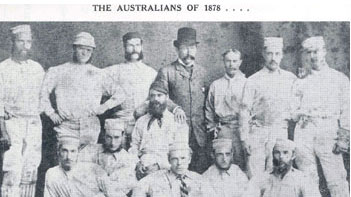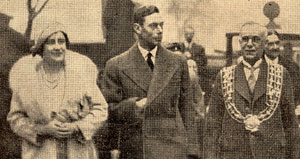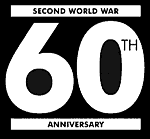Calderdale has long been an area rich in its own customs and traditions and home to independent-spirited people. It has been an outward looking area, welcoming people from other countries of the world and playing its own part in national and international events.
In 1878, there was an international buzz to Calderdale cricket when an Australian touring team to play Elland and District. In a very different era, the region had two lively days of celebrations to mark VJ Day, the end of World War Two, in August 1945.
Australian cricketers visited Calderdale
The Aussies come to Elland

Perhaps it did not quite have the flavour of the Ashes, but there was an international buzz to Calderdale cricket when an Australian touring team came to play Elland and District on June 6-8, 1878.
The Australians were even then more than a match for their regular opponents and to even things up a bit local teams were allowed to augment their numbers and some opponents in their home country had even fielded 22 players, without being able to win! Elland and District fielded 18 men.
Play each day started at about 12noon and ended at 6pm, with a break for lunch around 2pm.
The Australian second innings added 83 to their combined score, but the total proved too much for the Calderdale men, The match was yet another in a winning series for the Australians.
- The local team won the toss and put the Australians in to bat. They set the local team a challenging total of 90.
- Elland and District, in reply, piled up 29. The Elland professional, Derbyshire man G. Hay, scored most with 9 runs.
- Aussie bowler Boyle had the enviable figures of 11 wickets for 12 runs. Seven of those were taken in eight balls, which included two hat-tricks!
- Top bowler for Elland and District was Osborne, with figures of 6-40 and 6-33.
The 1937 Royal Visit

It was a misty autumn day in October 1937 when the newly crowned King George VI and Queen Elizabeth paid a visit to Halifax.
Enthusiastic crowds began assembling early on the morning of October 20, the arrival of the Royal visitors being signalled by a 21-gun salute from Beacon Hill.
The couple were welcomed by the Mayor of Halifax, Councillor Crossley Hodgson and the first port of call was Shibden Hall where lunch was provided. The King and Queen were reported to be 'charmed' with Shibden Hall (museums) and the surroundings, although unfortunately mist prevented a good view of the park.
After lunch the royal cavalcade proceeded to the Town Hall, crowds of excited onlookers lining the route. Many workers had been given a half-day holiday or extended lunch break in honour of the visit.
On arrival at the Town Hall, the King and Queen mounted a specially erected platform, trimmed with purple and gold.
Among those presented to the couple were the touring Australian Rugby League team who appear to have caused some amusement with their rendition of the team's 'war cry'. It was reported proudly that the Halifax Rugby League team had been the first to defeat the Australians during the tour.
As the party left to travel to Savile Park via King Cross, extra police had to be drafted in to control the crowds lining the streets.
It was estimated that nearly 10,000 cheering children were on the streets and almost as any flags as children. The Halifax Courier and Guardian reported that at the sides of the roads seats had been brought out so that 'old folks and invalids' could view the proceedings. To entertain the waiting crowds, King Cross Band played a selection of light music.
As the procession progressed down Free School Lane, there was a more sedate fluttering of handkerchiefs at the Royal Halifax Infirmary. Patients well enough to be outside joined nurses and other staff and the Queen apparently had a special smile for them.
There were similar scenes at the General Hospital as the cars passed down Salterhebble Hill en route to Elland. An ornamental archway had been erected at Elland Wood Bottom, under which the party passed before continuing to Elland and Brighouse.
The King's message to Yorkshire after the visit expressed pleasure in visiting the 'great county with whose capital we were so long associated 'and expressed warmest thanks for the wonderful welcome.
The local studies section in the Reference Library has additional resources relating to this and other royal visits, such as programmes and newspaper cuttings.
Victory in Japan (VJ) Day

After a day of rumours, the announcement of Japan's surrender finally came on 15th August 1945 at midnight. Too late for mass jubilation, but some people around the borough were certainly still up and indeed up for it! Bonfires were lit in various locations and celebrations went on until dawn.
The following two days were declared holidays and pub licensing hours were extended until midnight on both days – although a smaller report in the Courier noted ruefully that “only about half the public houses in the district had beer for sale”! Similarly, a lack of supplies hindered any hopes of firework celebrations. Also, as staff were already overstretched on the buses, no late services could be run.
Nevertheless, people were ready to mark the occasion. The streets around the borough were a hive of activity in the morning, as people put up decorations in commemoration of the long-awaited peace. Halifax Town Hall, other municipal buildings, Bull Green and Southgate were decorated with bunting and the flags of 34 nations and Ripponden Council Offices sported garlands of fairy-lights.
Rain rather dampened proceedings for events arranged during the day, such as billets and bowling tournaments at Hebden Bridge and fairground amusements at Manor Heath, as well as numerous open-air dances around the borough. However, come the evening Wainhouse Tower was floodlit from dusk till midnight, the Beacon Pan above Halifax was lit, searchlights criss-crossed the skies in the upper valley and people flocked into their local towns to see what was going on. Sightseeing, socialising and dancing went on until midnight and even later in some parts; and newspapers reported a rather slow start to the next day!